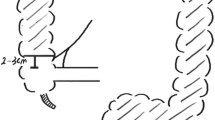Abstract
Background
Total colectomy is the surgery of choice for colonic inertia (CI) when medical treatment has failed. Laparoscopic total colectomy has demonstrated to be a feasible technique.
Objective
Present our experience in patients with CI who underwent laparoscopic total colectomy (TC) + ileorectoanastomosis (IRA) and evaluate the functional results and medium-term follow-up after this surgery.
Material and methods
All patients with CI were included in a prospective laparoscopic surgical protocol, from 2002 to 2007. These patients had a complete work-up for chronic constipation (clinical records, barium enema, colonic transit time, defecography, anorectal manometry, small bowel follow through). All patients were evaluated with Wexner’s score for constipation pre- and postoperatively, asked if they would recommend surgery to other patients, and if they were satisfied with the procedure (on a scale from 1 to 10). Statistical analysis was carried out using Student’s T-test.
Results
In this period 20 patients were operated with diagnosis of CI. All patients were females with an average age of 41.5 years (range 18–52 years). Mean operative time was 248 min (range 170–360 min). One (5%) patient was converted to open surgery. The medium time to flatus per anum and feeding was 2 (range 1–6) and 3 (range 2–6) days, respectively. The medium postoperative stay was 7 days. Seven patients (35%) presented surgical postoperative complications (three postoperative ileus, one portal thrombosis, one rectal hemorrhage, one anastomotic leakage, and one hemoperitoneum). There was no postoperative mortality. The average follow-up was 25 months (range 1–60 months). Preoperative Wexner’s constipation score was 22.3 (range 19–29 months) pre surgery and at the end of follow-up was 1.8 (range 0–6) (p < 0.01). The medium level of satisfaction was 8 (range 2–10) and only one patient would not recommend surgery to other patients.
Conclusion
The laparoscopic access is a safe technique with satisfactory functional results after medium-term follow-up.
Similar content being viewed by others
References
Talley NJ, Zinsmeister AR, Van Dyke C, Melton LJ 3rd (1991) Epidemiology of colonic symptoms and the irritable bowel syndrome. Gastroenterology 101:927–934
Higgins PD, Johanson JF (2004) Epidemiology of constipation in North America: a systematic review. Am J Gastroenterol 99:750–759
Schouten WR, de Graaf EJ (1991) Severe, long-standing constipation in adults: indications for surgical treatment. Neth J Surg 43:222–229
Sonnenberg A, Koch TR (1989) Epidemiology of constipation in the United States. Dis Colon Rectum 32:1–8
Pinedo G, López F, Soto G, Zúñiga A, Rahmer A, Miquel JF, Clavería M (2004) Resultados del tratamiento quirúrgico en inercia colónica. Rev Chil Cir 56:27–30
Fan CW, Wang JY (2000) Subtotal colectomy for colonic inertia. Int Surg 85:309–312
Pikarsky AJ, Singh JJ, Weiss EG, Nogueras JJ, Wexner SD (2001) Long-term follow-up of patients undergoing colectomy for colonic inertia. Dis Colon Rectum 44:179–183
Eu KW, Lim SL, Seow-Choen F, Leong AF, Ho YH (1998) Clinical outcome and bowel function following total abdominal colectomy and ileorectal anastomosis in the Oriental population. Dis Colon Rectum 41:215–218
Sample C, Gupta R, Bamehriz F, Anvari M (2005) Laparoscopic subtotal colectomy for colonic inertia. J Gastrointest Surg 9:803–808
Nakamura T, Pikarsky AJ, Potenti FM, Lau CW, Weiss EG, Nogueras JJ, Wexner SD (2001) Are complications of subtotal colectomy with ileorectal anastomosis related to the original disease? Am Surg 67:417–420
Elton C, Makin G, Hitos K, Cohen CR (2003) Mortality, morbidity and functional outcome after ileorectal anastomosis. Br J Surg 90:59–65
Gutt CN, Oniu T, Schemmer P, Mehrabi A, Buchler MW (2004) Fewer adhesions induced by laparoscopic surgery? Surg Endosc 18:898–906
López F, Soto G, Zárate A, Pinedo G, Pérez G, Avendaño R, García-Huidobro I, Ibáñez L (2003) Protocolo de cirugía laparoscópica intestinal. Rev Chil Cir 55:225–231
Holte K, Kehlet H (2000) Postoperative ileus: a preventable event. Br J Surg 87:1480–1493
Agachan F, Chen T, Pfeifer J, Reissman P, Wexner SD (1996) A constipation scoring system to simplify evaluation and management of constipated patients. Dis Colon Rectum 39:681–685
Jorge JM, Wexner SD (1993) Etiology and management of fecal incontinence. Dis Colon Rectum 36:77–97
Lane WA (1908) Results of the operative treatment of chronic constipation. BMJ 1:1126–1130
Lundin E, Karlbom U, Palman L, Graf W (2002) Outcome of segmental colonic resection for slow-transit constipation. Br J Surg 89:1270–1274
You YT, Wang JY, Changchien CR, Chen JS, Hsu KC, Tang R, Chiang JM, Chen HH (1998) Segmental colectomy in the management of colonic inertia. Am Surg 64:775–777
Preston DM, Hawley PR, Lennard-Jones JE, Todd IP (1984) Results of colectomy for severe idiopathic constipation in women (Arbuthnot Lane’s disease). Br J Surg 71:547–552
Bernini A, Madoff RD, Lowry AC, Spencer MP, Gemlo BT, Jensen LL, Wong WD (1998) Should patients with combined colonic inertia and nonrelaxing pelvic floor undergo subtotal colectomy? Dis Colon Rectum 41:1363–1366
Pemberton JH, Rath DM, Ilstrup DM (1991) Evaluation and surgical treatment of severe chronic constipation. Ann Surg 214:403–413
Eu KW, Lim SL, Seow-Choen F, Leong AF, Ho YH (1998) Clinical outcome and bowel function following total abdominal colectomy and ileorectal anastomosis in the oriental population. Dis Colon Rectum 41:215–218
Webster C, Dayton M (2002) Results after colectomy for colonic inertia: a sixteen-year experience. Am J Surg 186:639–644
Piccirillo MF, Reissman P, Wexner SD (1995) Colectomy as treatment for constipation in selected patients. Br J Surg 82:898–901
Knowles CH, Scott M, Lunniss PJ (1999) Outcome of colectomy for slow transit constipation. Ann Surg 230:627–638
Author information
Authors and Affiliations
Corresponding author
Rights and permissions
About this article
Cite this article
Pinedo, G., Zarate, A.J., Garcia, E. et al. Laparoscopic total colectomy for colonic inertia: surgical and functional results. Surg Endosc 23, 62–65 (2009). https://doi.org/10.1007/s00464-008-9901-4
Received:
Revised:
Accepted:
Published:
Issue Date:
DOI: https://doi.org/10.1007/s00464-008-9901-4




